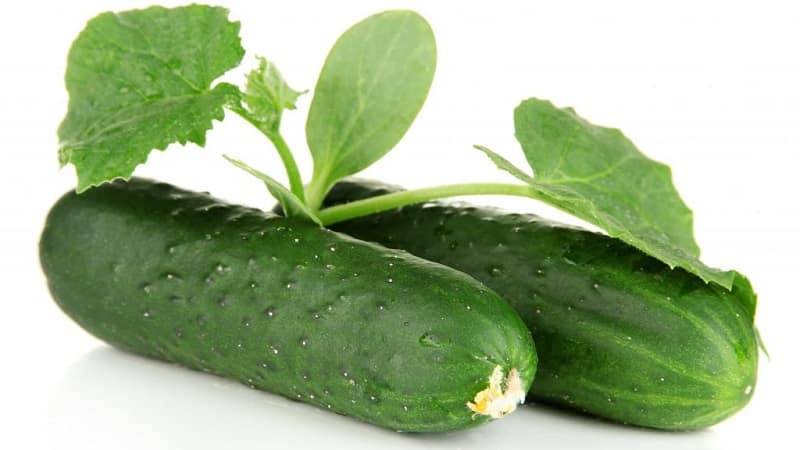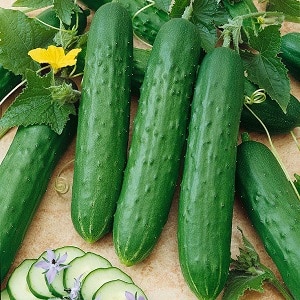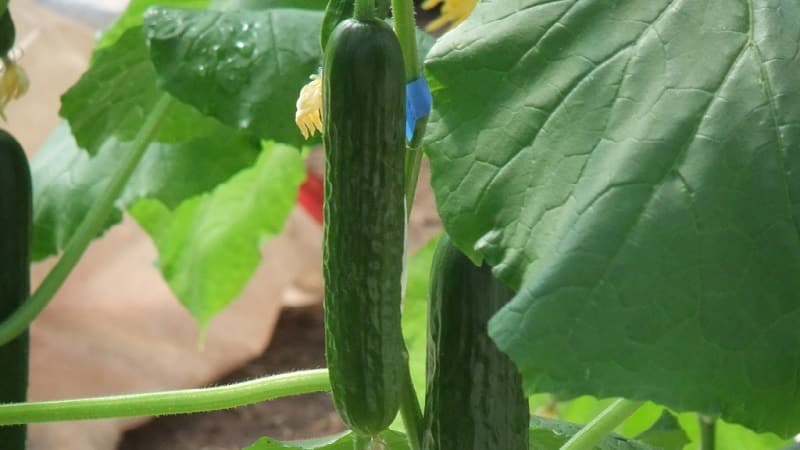Zozulya cucumbers, the most popular among gardeners, for greenhouses and open ground
It is a rare gardener who does not want to get a harvest of cucumbers as soon as possible. The Zozulya f1 hybrid will provide this opportunity. In the article we will look at a detailed description of the hybrid, instructions for growing it, and the main advantages and disadvantages. We will also share with you popular reviews from farmers about cucumbers.
Characteristics and description of Zozulya cucumbers
Gardeners often use greenhouses and greenhouses to speed up the ripening of crops. For such growing methods, various hybrids and varieties of cucumbers are bred, Zozulya is no exception.

Distinctive features
The hybrid was bred by Russian breeders. It is found in most regions of Russia. It is cultivated in open and closed ground, but the hybrid produces more yield when grown in film.
Zozulya ripens early. The length of the fruit is from 15 cm, weight - up to 300 g. The shape of the cucumbers is cylindrical, the color is rich green. The seeds inside the fruit are small and soft.
Composition, properties, benefits, calorie content
Zozulya cucumbers have white spines and thin skin. The pulp is juicy, aromatic, dense in consistency. The taste of cucumber is sweetish.
A distinctive feature is that the fruits do not taste bitter and retain their presentation for a long time.. Cucumber contains 14 kcal, 0.8 g protein, 0.1 g fat, 2.5 g carbohydrates. The fruits are good for the body: they increase appetite and have a choleretic and diuretic effect.
Characteristics of bushes, productivity
Hybrid bushes are weakly climbing. They do not form stepsons, which simplifies care. The flowers are parthenocarpic and do not require pollination by insects.The plants are vigorous, unpretentious, tolerate temperature changes and are resistant to disease.
The taste of the fruit is delicate, aromatic and juicy, the skin is not bitter. Productivity - 15 kg per 1 m², in the first month - about 10 kg.
How to grow your own
To grow this hybrid in a greenhouse, you should choose a flat, sunny area that will be protected from the wind. The soil should be light and fertile.
If the soil is of poor quality, fill the greenhouse with a mixture of peat soil and humus. Before planting, the soil is disinfected. To do this, dissolve 3 g of potassium permanganate in 10 liters of hot water and water the ground generously.
Other varieties of cucumbers:
How to grow Harmonist cucumbers and why they are good
Planting by seeds and seedlings
The seed method is rarely used, only if there is a film cover. Seeds are soaked in water for an hour before sowing. The copies that surfaced are unusable and are thrown away. Those that have sunk to the bottom are rinsed, wrapped in a damp cloth and placed in a warm place for several days.

As soon as the sprouts appear, they begin sowing. Holes are made in the rows every 30 cm. Some of the humus and fertilizer is poured into the bottom of each dug hole, after which 0.5 liters of water are poured. After absorbing the moisture, place three seeds into the holes and sprinkle with dry soil. Sowing begins after the air warms up to +20 °C.
Reference. Sprouted plants are thinned out, leaving only strong crops in the hole.
An important condition for such cultivation is - so that each seed germinates and turns into a full-fledged plant.
 Stages of growing seedlings:
Stages of growing seedlings:
- Warming up. Even the best seeds may not sprout.To avoid this, warm up. Several months before sowing, cucumbers in bags are placed near heating devices, the temperature of which is about +30 °C. If it is higher, then you can reduce the duration of the procedure by a couple of days. This will increase the likelihood of good seedlings and increase the number of flowers on the bushes.
- Calibration. The process is similar to sowing cucumbers in the ground. The seeds are poured with clean water or a mixture with potassium permanganate. After some time, the water is poured out. The seeds that rise to the surface of the water are thrown away, leaving only the sunken ones.
- Germination. The seeds are wrapped in damp cloth and placed in a warm place with a temperature of +30 °C for several days. You cannot place them in gauze, as the roots of the sprouts will get tangled and stuck, which will complicate the task and increase the possibility of damage to the seeds.
- Landing. The seeds are sown in special cups with a mixture of soil. From the moment of sowing until the appearance of the first shoots, the temperature is maintained at +30 °C. When the first leaf appears, it is lowered to +20 °C to prevent the seedlings from stretching.
The bushes are regularly watered and ventilated. It is important that there is about 13 hours of daylight. After a month, the seedlings are ready to be planted in the greenhouse. Holes 15 cm deep are dug in special rows and humus and fertilizers are added to them. The seedlings are carefully shaken out of the pots and placed in the holes. Then they are covered with earth and lightly compacted.
Growing and care
In order for the Zozulya hybrid to produce a good harvest, it is important to follow the rules of agricultural technology. Cucumber vines should be tied to supports, weeds should be removed, and the ground should be loosened. Be sure to water the plants and fertilize the crops with vitamins and fertilizers.

The hybrid is demanding on moisture, therefore water consumption - 1 liter per adult bush. The result will be better if you add combined organic-mineral fertilizers and fertilizers. They are applied at the root and along the leaves. The hybrid responds well to concentrated chicken manure.
It’s easy to prepare: dry droppings are poured with water in a 1:1 ratio. The vessel with this mixture is closed and left for a week. The mixture is used in diluted form.
Features of cultivation and possible difficulties
So that early shoots do not suffer from temperature changes, it is recommended to cover the seedlings immediately after planting. Since cucumbers love moisture, seedlings are watered abundantly. Leave the water for several days to warm it up - cold watering harms the plant. Excess moisture can negatively affect the hybrid, causing disease.
The best time to water is morning or evening. Loosening is done to provide air to the root system and to prevent weeds from feeding on important nutrients from the soil. To develop and improve the bush, pinch the central sprout. This method also saves cucumbers from infertility.
Reference. Fertilize every two weeks.
Diseases and pests
 The hybrid has good resistance to olive spot and root rot. But there are others diseases that can affect the plant. These include powdery mildew, ascochyta blight and bacteriosis. Fungal diseases are dangerous due to high humidity in the greenhouse.
The hybrid has good resistance to olive spot and root rot. But there are others diseases that can affect the plant. These include powdery mildew, ascochyta blight and bacteriosis. Fungal diseases are dangerous due to high humidity in the greenhouse.
To prevent these diseases, seeds are treated with fungicides “Vincit” and “Saprol”. When grown in greenhouses, the walls and ceiling are treated with a formaldehyde solution.
If the disease has already spread, the affected leaves are removed and burned, and the plants are sprayed with Bordeaux mixture or a solution of urea with copper sulfate, and the stems are rubbed with a mixture of copper and chalk.
From folk methods of combating fungal diseases are popular:
- treatment with fermented milk whey diluted with cold water in a ratio of 1:10;
- iodine solution - 25 ml of iodine dissolved in 10 liters of water;
- onion decoction - 0.7 liters of onion peel is boiled for one minute in 10 liters of water, left for 12-15 hours, diluted with water in a ratio of 1:4, then sprayed on the plants and watered the soil.
To combat the invasion of aphids, which sometimes infect cucumber beds, gardeners use insecticides (“Decis”).
Harvesting and application
Harvesting occurs once every 5 days to stimulate the formation of new fruits. The harvest is used mainly for salads. It is also suitable for pickling and preservation.
Advantages and disadvantages
The advantages of Zozulya include early ripening, ease of care due to the absence of the need to attract insects for pollination. Other advantages are unpretentiousness and resistance to many diseases, high yield and juicy taste of the fruit.

The hybrid has few disadvantages. These include the fact that for increased productivity it is necessary to grow the plant only in protected and specially prepared soil.
Read also:
Reviews
 Gardeners speak positively about the Zozulya hybrid and recommend growing it to those who are willing to devote time and effort to caring for plants.
Gardeners speak positively about the Zozulya hybrid and recommend growing it to those who are willing to devote time and effort to caring for plants.
Galina, Belgorod: “We grew these cucumbers last summer, and the salads were incredibly tasty.I am very glad that I was able to find this hybrid. But at first I couldn’t grow them; there were always some problems. Either the yield is small or the fruits are small. As soon as I started paying closer attention to the plants, everything immediately improved. I am very glad that I can enjoy such a delicate taste".
Natalia, St. Petersburg: “I plant seeds in open ground every year. My first fruits grow long and very even. When the bush stops bearing fruits, they already appear crooked. But in general, this hybrid is recommended for greenhouse planting.".
Elena, Moscow: “I use these cucumbers only for salads, because they are large, long, and most importantly, they grow juicy. When we planted them and they began to grow and set fruit, we were immediately glad that there would be a lot of cucumbers. This turned out to be true, we planted a few seeds, there was a lot of fruit, and we reaped a good harvest.”.
Conclusion
The Zozulya hybrid is one of the most popular and suitable for harvesting a large harvest. Cucumbers have a pleasant taste and grow quickly. The hybrid has more advantages and disadvantages than disadvantages. Therefore, farmers who want to grow tasty and juicy cucumbers choose this hybrid.